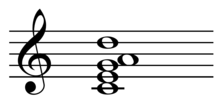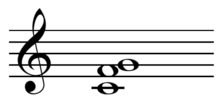Jazz chord
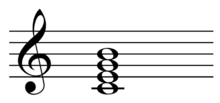
Jazz chords refer to chords, chord voicings and chord symbols that jazz musicians commonly use in composition, improvisation, and harmony. In jazz chords and theory, most triads that appear in lead sheets or fake books can have sevenths added to them, using the performer's discretion and ear. For example, if a tune is in the key of C, if there is a G chord, the chord-playing performer usually "voices" this chord as G7. While in a strict classical music context, the notes of a G7 chord would be G–B–D–F, jazz often omits the fifth of the chord—and even the root if playing in a group. However, not all jazz pianists leave out the root when they play voicings: Bud Powell, one of the best-known of the bebop pianists, and Horace Silver, whose quintet included many of jazz's biggest names from the 1950s to the 1970s, included the root note in their voicings.[1][2]
Omitting the root and fifth gives the improvising chord-playing musician the option to play other notes. Also, if a seventh chord, such as G7, appears in a lead sheet or fake book, many chord-playing performers add the ninth or thirteenth to the chord, even though the lead sheet does not specify these additional notes.
Jazz players can add these additional, upper notes–seventh, ninth, eleventh, and thirteenth–because they are an important part of the jazz sound. Lead sheets and fake books often do not detail how to voice the chord because a lead sheet or fake book is only intended to provide basic guide to the harmony. An experienced "comping" performer playing electric guitar or piano adds the extra notes using their ear and taste.
In voicing jazz chords, performers focus first on the seventh and the major or minor third of the chord, with the latter indicating the chord quality, along with added chord extensions (e.g., ninths, elevenths, or thirteenths, even if not indicated in the lead sheet or fake book) to add tone "colour" to the chord. As such, a jazz guitarist or jazz piano player might "voice" a printed G chord with the notes B–E–F–A, which would be the third, sixth (thirteenth), seventh, and ninth of the chord. Jazz chord-playing musicians may also add altered chord tones (e.g., ♭9, ♯9, ♯11, ♭13) and added tones. An example of an altered dominant chord in the key of C, built on a G would be to voice the chord as "B–C♯–E–F–A♭"; this would be G7(♭9♯11).
Nomenclature
Intervals
Each chord is described as a series of intervallic relationships to the root of the chord. This provides an accurate and easily understandable basis for working out these chords in each key.
The terms used to describe intervals are as follows:
- r = root of the chord (while the root is widely used in classical music, pop music and rock music chord voicings, in jazz, the root is often omitted by the chord-playing performer(s))
- ♭2 = minor second = 1 semitone(half step) above root
- 2 = major second = 2 semitones above root
- ♯2 = augmented second = 3 semitones above the root
- ♭3 = minor third = 3 semitones above the root
- 3 = major third = 4 semitones above the root
- 4 = perfect fourth = 5 semitones above the root
- ♯4 = augmented fourth (tritone) = 6 semitones above the root
- ♭5 = diminished fifth (tritone) = 6 semitones above the root
- 5 = perfect fifth = 7 semitones above the root (while the fifth is widely used in classical music, pop music and rock music chord voicings, in jazz, the fifth is often omitted by the chord-playing performer(s))
- ♯5 = augmented fifth = 8 semitones above the root
- ♭6 = minor sixth = 8 semitones above the root
- 6 = major sixth = 9 semitones above the root
- 7 = minor seventh = 10 semitones above the root
- M7 = major seventh = 11 semitones above the root
All root chords are described starting with the lowest note, and ascending in pitch. For instance, a chord described as
r 3 5
contains the root, a major third above the root and a perfect fifth above the root (major chord). If this chord were built on B♭ (with B♭ as the root), it would contain the notes
B♭ (root) D (root + a major third) F (root + a perfect fifth).
Compound intervals
Compound intervals are those intervals greater than an octave. They can also be described as an octave plus a simple interval. Note that this is not a complete list of compound intervals, but only those that are commonly used in jazz chords.
- ♭9 = compound minor second (minor ninth) = 1 semitone + an octave = 13 semitones above the root
- 9 = compound major second (ninth) = 2 semitones + an octave = 14 semitones above the root
- ♯9/♭10 = compound augmented second/minor third (augmented ninth/minor tenth) = 3 semitones + an octave = 15 semitones above the root.
- 10 = compound major third (tenth) = 4 semitones + an octave = 16 semitones above the root
- 11 = compound perfect fourth (eleventh) = 5 semitones + an octave = 17 semitones above the root
- ♯11 = compound augmented fourth (augmented eleventh) = 6 semitones + an octave = 18 semitones above the root
- ♭13 = compound minor sixth (minor thirteenth) = 8 semitones + an octave = 20 semitones above the root
- 13 = compound major sixth (thirteenth) = 9 semitones + an octave = 21 semitones above the root
Extensions
Optional extensions to the chords are written in parentheses, e.g. (♯11). These notes are not necessary to define the function of the chord, but are included to add colour or fill out the sound according to the tastes of the performer. Extensions may be written into the chords when a specific colour or texture is warranted, or the chords in a lead sheet or fake book may simply state "C7 – A7 – D7 – G7". This does not mean that the chord-playing performer can only perform four-note dominant seventh chords. Chord-playing performers can use their ear, their sense of good taste acquired from listening to jazz, and their knowledge of the style of the tune being played (e.g., is it a Bebop tune or a jazz fusion tune) to help guide her use of extension notes, altered extensions, and added tones. In a band, the bandleader might request that certain voicings be used (e.g., ♭9/♯11) or request that certain other voicings be avoided (e.g., ♭13), due to the bandleader's taste.
Voicings
Chords are described here in terms of intervals relative to the root of the chord, arranged from smaller intervals to larger. This is a standard method used when describing jazz chords as it shows them hierarchically: Lower intervals (third, fifth and seventh) are more important in defining the function of the chord than the upper intervals or extensions (9th, 11th, 13th), which add color. Although it is possible to play the chords as described here literally, it is possible to use different orderings of the same notes, known as a voicings, or even by omitting certain notes.
For instance, the dominant 7th ♯11 or Lydian dominant (C7♯11) comprises the notes:
root (usu. omitted) 3 (5) 7 (9) ♯11 (13)
.png)
Basing this chord on the pitch, C, results in the pitches:
C (usu. omitted) E G B♭ D F♯ A
The same chord type may also be voiced:
C (usu. omitted) E B♭ F♯ A D F♯
This voicing omits both the root and the perfect fifth (G) and raises the major ninth (D) by an octave. The augmented eleventh (F♯) is also played twice in two different registers. This is known as "doubling".
Chord types
Basic chord types
The above chords, despite their differences, share the same harmonic function and can be used interchangeably.
Major chords

Major seventh (CΔ7, CΔ,Cmaj7)
r 3 5 M7 (9)
- Δ7 has the same meaning as maj7 or CΔ. Often melody notes or other pitches influence an improviser's choice of chord types. For example, if the melody note is the root of the chord, including a major seventh can cause dissonance.

Major sixth (C6)
root (usu. omitted) 3 5 6
Major 6-9 (C6/9 or C6add9)
root (usu. omitted) 3 5 6 9
.png)
Lydian (CΔ♯11)
root (usu. omitted) 3 5 M7 (9) ♯11 (6))
- The Lydian chord has a strange quirk, where if you put the root both above and below the augmented eleventh it creates an unpleasant dissonance of a tritone. This is not usually a problem in a jazz context, as chord-playing musicians often omit the root.
- The interval of the sixth is used, even though it is described after other compound intervals, and perhaps should also be a compound interval (i.e., 13th). However, a convention in jazz dictates that when describing the major sixth, generally use the simple interval, i.e., 6 is often used instead of the compound interval, i.e., 13. This helps avoid confusion with the dominant thirteenth (see below).
Basic dominant chords
Basic describes dominant chords based on the major scale. In many instances, dominant chords written as a basic chord (e.g., C13) can substitute for a more complex chord, as long as it remains part of the same group (i.e., dominant chords) and does not clash with the melody note.
Dominant chords are considered to sound unstable in a classical music harmony context, and so in a classical piece, these chords often resolve down a perfect fifth or up a perfect fourth (e.g. C7 tends to resolve onto chords based on F, such as F major or F minor). However, in a jazz context, particularly in music from the 1940s Bebop era and later decades, dominant chords were no longer treated as "unstable" chords. Some Bebop tunes use a dominant chord as the tonic chord and also use dominant chords for the chords that would typically be minor chords in a Classical piece or a Swing arrangement. For example, while a Classical piece and a Swing arrangement might use the following chord sequence in the key of C major: "C – Am – Dm – G7", a Bebop bandleader might reharmonize the same progression as "C7 – A7 – D7 – G7", making a sequence of dominant seventh chords, so long as the new dominant chord harmonies were compatible with the tune's melody. For more details, see chord progression.
Many of the chordal alterations used in jazz are derived from minor scale modes, as opposed to the major scale modes. (See musical mode). If the performer retains the 13th in the chord and/or avoids playing a ♭13th, it can be substituted for a C13♭9. Likewise a C9 can often be substituted for a Cmaj9♯5, as long as the 9th is retained or the ♭9th and ♯9th is avoided.
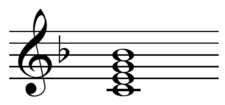
Dominant seventh (C7)
root (usu. omitted) 3 5 (usu. omitted) 7 (9) (13)
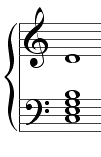
Dominant ninth (C9)
root (usu. omitted) 3 5 (usu. omitted) 7 9 (13)
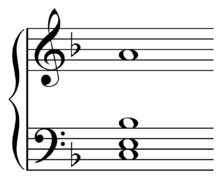
Dominant thirteenth (C13)
root (usu. omitted) 3 5 (usu. omitted) 7 (9) 13
- This particular symbol is often used if the 13th is found in the melody.
Sus, or suspended chord (C7sus4)
root 4 5 7 (9) (13)
Minor seventh chords
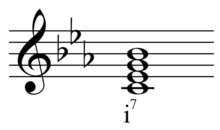
Minor seventh (C−7, Cmin7, Cmi7, or Cm7)
r ♭3 5 7 (9) (11) (13)

Minor ninth (C−9, Cmin9, Cmi9, or Cm9)
r ♭3 5 7 9 (11) (13)

Minor eleventh (C−11, Cmin11, Cmi11, or Cm11)
r ♭3 5 7 (9) 11 (13)

Minor thirteenth (C−13, Cmin13, Cmi13, or Cm13)
r ♭3 5 7 (9) (11) 13
Complex chord types
Complex dominant chords
These chords can be voiced in a great variety of ways, including building the chord on the 7 (minor seventh). They usually, but not always, lead to a minor chord built on an interval 4th up from the root. It is also not unusual to express either the ♯9 or ♭9 or the ♯5 in the melody. For expediency, musicians may use the abbreviation "alt"—as in C7alt—to describe the family of dominant chords with "altered" tones (including the ♭5, ♯5, ♭9, ♯9, or ♭13). Coincidentally, all altered tones mentioned above are present in the melodic minor scale whose root is a half-step above the root of the alt chord (i.e., E♭ melodic minor for D7alt) In the previous dominant chords, it was noted that the perfect fifth is often omitted. When the fifth is augmented, as with the chords below, the fifth is played by chord-playing musicians.
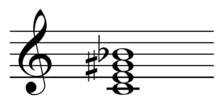
Dominant ♯9/♯5 (C7(♯5♯9))
root (usu. omitted) 3 ♯5 7 ♯9
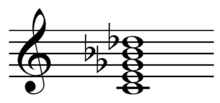
Dominant ♭9/♯5 (C7(♯5♭9))
root (usu. omitted) 3 ♯5 7 ♭9
Sources
- ↑ "Bud Powell Chord Voicings - The Jazz Piano Site". The Jazz Piano Site. Retrieved 2018-08-30.
- ↑ "5 Ways to Play Like Horace Silver | Jazz | Piano". Scribd. Retrieved 2018-08-30.
- ↑ Benward & Saker (2009), p.185.
- ↑ Benward & Saker (2009). Music in Theory and Practice: Volume II, p.179. Eighth Edition. ISBN 978-0-07-310188-0.
- ↑ Kostka & Payne (1995). Tonal Harmony, p.493. Third Edition. ISBN 0-07-300056-6.
Further reading
- Nettles, Barrie & Graf, Richard (1997). The Chord Scale Theory and Jazz Harmony. Advance Music, ISBN 3-89221-056-X.
External links
- The Jazz Resource Jazz chords and theory
